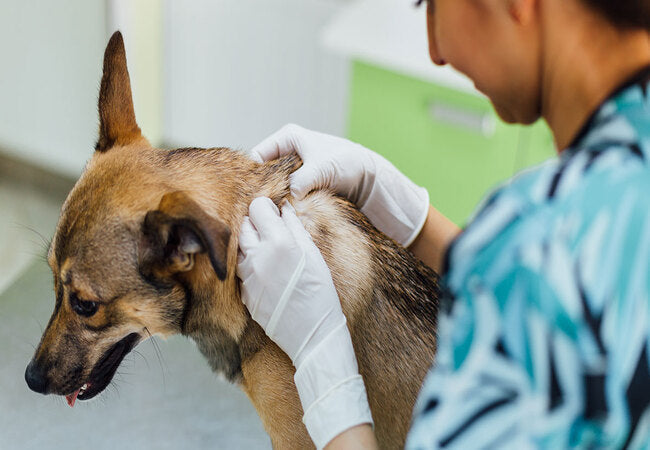Veterinary Guide to Canine Tick Paralysis 2025: Signs, Emergency Care & Prevention 🐾🐶

In this article
Veterinary Guide to Canine Tick Paralysis 2025: Signs, Emergency Care & Prevention 🐾🐶
By Dr. Duncan Houston BVSc
🔍 What Is Tick Paralysis?
Tick paralysis is an acute, progressive motor paralysis in dogs triggered by neurotoxins in saliva from certain female ticks, especially Dermacentor and Ixodes species. The toxin blocks neuromuscular transmission, causing ascending paralysis—from hind limbs upward—and can be fatal if respiratory muscles are affected.
🕒 Prevalence & Seasonality
- Occurs primarily during peak tick activity—spring to early summer in North America, and year-round in some Australian regions.
- Although rare, it strikes quickly; the toxin is delivered 3–7 days post-attachment, making vigilance key.
⚠️ Early Signs & Clinical Signs
- First hints: raspy, throat-clearing bark; hind-limb weakness or wobbliness.
- Progressive signs (2–7 days): ataxia, vomiting or gagging, generalised weakness.
- Advanced stages: full paralysis, laboured breathing, voice changes, drooling, dilated pupils.
- Without tick removal and care, respiratory failure can be fatal.
🔬 How It Works
The feeding tick releases a salivary neurotoxin that inhibits presynaptic calcium channels at neuromuscular junctions, causing progressive motor nerve impairment. The toxin effect halts once the tick is removed.
🩺 Diagnosis & Assessment
- Based on clinical signs and detection of an attached tick, often hidden in ear folds, between toes, tail base, or collar area.
- Diagnostics include full body tick search, neurological exam (noting diminished reflexes), and labwork to rule out other causes.
- Thoracic imaging may be needed if the respiratory muscles or megaesophagus are involved.
🚨 Immediate Treatment Steps
1. Tick Removal
- Have your veterinarian remove all ticks thoroughly using forceps or a scalpel—skin portions left by the tick can prolong toxin exposure.
- Toxin stops accumulating once all ticks are removed, and symptoms often begin reversing within hours.
2. Supportive Hospital Care
- Oxygen therapy and ICU-level respiratory support may be required if breathing is compromised.
- Fluids, anti-nausea meds, warmth, and nutritional support for vomiting or gagging dogs.
- Mechanical ventilation if paralysis affects diaphragmatic function.
3. Recovery Expectations
- Improvement commonly begins within 8–24 h post-removal.
- Complete recovery typically occurs within 1–3 days.
- In rare cases (~5%) in North America or more in Australia, fatal outcomes may occur from severe paralysis.
🏠 Home Care & Aftercare
- Rest and limit activity until full strength returns.
- Keep warm, comfortable, and upright for eating/drinking.
- Monitor breathing and gait daily during recovery.
- Schedule follow-up with vet if lag in improvement after 48 h.
🛡️ Prevention Is Key
- Year-round tick protection is essential—monthly oral chews (Simparica Trio) or topicals/collars like Seresto.
- Routine full-body tick checks after outdoor activity, especially hidden zones.
- Maintain tidy yards, remove brush/leaf litter; consider permethrin-treated gear and natural repellents.
📱 Telehealth Support in 2025
- Ask A Vet telehealth: Enables real-time vet guidance for tick checks, emergency removal, and symptom triage.
- Smart alerts and wearable monitors track breathing and motor recovery during convalescence.
👣 Quick Action Checklist
- Check your dog thoroughly for ticks (ears, toes, collar, tail base).
- See vet immediately if you notice weakness, cough, or bark changes.
- Tick removal and hospitalization (oxygen, fluids, warmth).
- Monitor for improvement—usually within 24–72 h.
- Continue tick preventives and yard maintenance.
- Use Ask A Vet for monitoring or follow-up support.
👨⚕️ Final Thoughts from Dr Duncan
Tick paralysis can escalate fast, but timely tick detection, veterinarian care, and hospitalization often lead to full recovery in days. In 2025, combining effective tick preventives, smart home monitoring, and telehealth backup makes prevention and recovery even more streamlined. Stay vigilant, and with help from Ask A Vet, ensure your dog stays safe every outdoors season. 💙
Visit AskAVet.com or download the Ask A Vet app for 24/7 vet support on tick paralysis—detection tips, emergency advice, and recovery check-ins.






